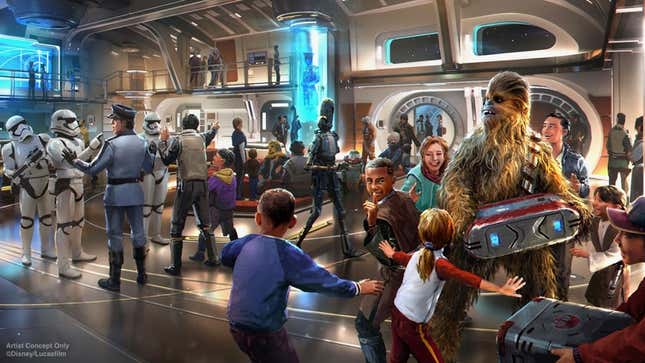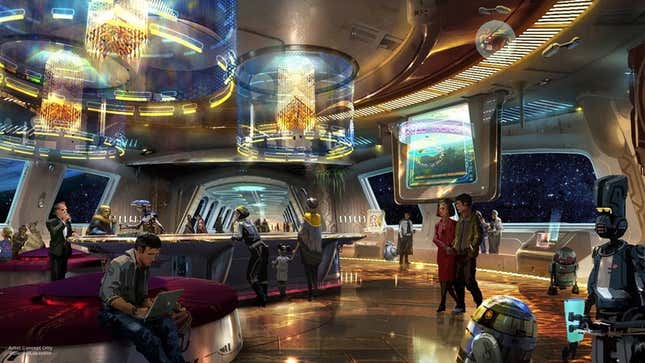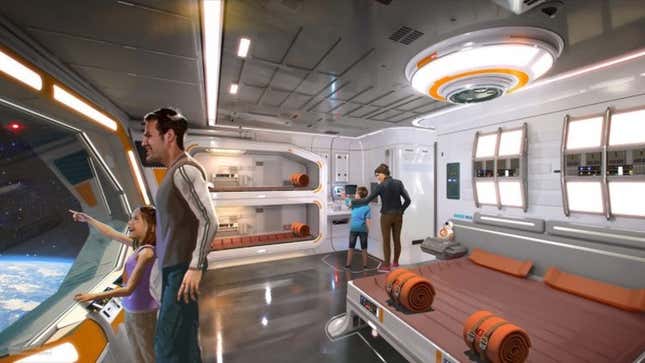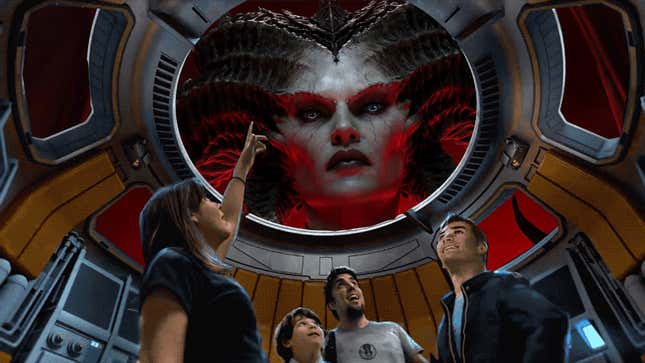Unless you’ve been living under a rock on Exegol for the last month, you’ve probably heard of YouTuber Jenny Nicholson’s viral, four-hour-long video reviewing the Star Wars hotel, officially known as Star Wars: Galactic Starcruiser. Titled “The Spectacular Failure of the Star Wars Hotel,” it goes into excruciating detail about why the immersive (and expensive) experience went off like a Wookie fart in the Jedi Temple. Throughout the video, there are obvious parallels to recent, spectacularly bad video game launches centered around popular IP, like Suicide Squad: Kill the Justice League and Marvel’s Avengers. It’s almost as if no amount of lucrative lore can save something when it’s rushed or half-assed, am I right?
Star Wars: Galactic Starcruiser opened on March 1, 2022 and permanently closed a year and a half later in September, 2023. The “immersive” experience required guests to stay there for two nights—no more, no less. (Nicholson’s stay cost just over $3,000 per person, though the lowest possible option was $1,209 per person.) During your stay, you spend almost the entire time “on” the Starcruiser, which promised wild views of space you could glimpse through its fake windows, and an excursion to Disney’s Star Wars world, aka Galaxy’s Edge.
“Immersion” was the big promise here—you’d get pulled into your own unique storyline that was meant to seamlessly weave into other guests’ storylines as well as those of the cast members working at the hotel, like a real-world RPG. If you wanted to turn it into a proper LARPing (live action role playing) experience, you could even wear full Star Wars attire while staying there.
The experience proved lackluster for the price point, and thus the Galactic Starcruiser closed last year. Jenny Nicholson exhumed its corpse in her May 18 video, opening the floodgates for derision from fans, a litany of memes, and even a weird, PR-heavy ScreenRant article from a former Starcruiser employee.
There are so many details packed into this YouTube video (which is roughly the length of A New Hope and Empire Strikes Back combined), that I couldn’t even approach properly covering it, but there are some really stark parallels to poorly received video games that stand out, from the bugged quest lines to the bevy of microtransactions that serve as a reminder of the perils of putting all your eggs in one IP basket.

The Star Wars hotel: expectations vs reality
First, there’s the stark contrast between concept art and reality. Concept art is just that—a concept, so while there’s some expectation that the final product will at least resemble the concept art, it’s not something that can make or break a video game or a real-world experience. Except, that is, when the wonder and promise of the concept art dwarfs the reality of the final product, or when things from that concept art are excised from the final product entirely. Both of those things happened at the Star Wars hotel.
All of the concept art for the Galactic Starcruiser showed that the common areas would be bustling hives filled with space citizens and droids, while giant windows offered a breathtaking look out into space. As Nicholson shows in her video, the lobby of the hotel has a few tiny windows that are way up high on the walls, far enough away to avoid close inspection, and nowhere near eye-level. Meanwhile, the space station-themed restaurant in Epcot has a ton of gigantic fake windows looking out into virtual space.
Things were clearly rushed or cut here. There was one droid roaming around amongst hotel guests, not several skittering around the space. There were a few actors in alien makeup, not a ton. Many times the actors and droids appeared in balcony in the lobby that was inaccessible to guests.
Nicholson even points out the rooms were needlessly small—as this isn’t a real cruise ship of the sea or the stars, there’s no similar size restrictions Disney had to stay within—likely to cut costs so that the company could maximize its profits.

The Star Wars hotel’s microtransactions
The astronomical cost of staying at the Star Wars hotel was already a problem, but when you add on the lack of transparency around pricing (as Nicholson explained, folks had to call a number to book their stay, and could only get a sense of the range of possible prices by comparing notes) and the tons of other, pay-walled experiences the hotel offered, I am violently reminded of the gaming industry’s love affair with live-service games and microtransactions.
At the Star Wars hotel, you could upgrade your seat during dinner time to the “Captain’s Table,” for $30 per person. You could pay $169 for the Memory Maker package, which ensured that the roaming photographers would snap pictures of you living this immersive experience and that you had access to unlimited downloads of those photos. You could also pay $399 for a half-hour private photo shoot, but this package was added at a later date, and appears to have negatively affected those who bought the original, $169 Memory Maker tier, as Nicholson claims she saw no roaming photographers during her stay—apparently they were too busy covering the private photo shoots.
And, as Nicholson points out, though your stay at the hotel would get you seven hours of time in the Disney parks, there were tons of paid add-ons that were not included: lightsaber building ($220), droid building ($100), or a table at Oga’s Cantina (food and drink not included). The Galactic Starcruiser staff also suggested people arrive the night before their stay so that they wouldn’t miss out on any of the activities—another hidden cost.
All of this is reminiscent of the recent, worrying trend: full-priced video games being released that are littered with microtransactions. This is different from free-to-play titles like Fortnite or Overwatch, which are also littered with microtransactions but at least allow you to get your foot in the door for free. The exorbitant pricing of the Star Wars hotel and its equally pricy add-ons is a direct parallel to AAA games charging the new $70 norm just to offer you even more crap to spend your hard-earned money on.
Like Suicide Squad: Kill the Justice League. Though it was developed by Batman Arkham studio Rocksteady, it adopted the microtransaction trend: You’d have to spend $70 to buy the game (which launched in a fairly broken state), and if you wanted to unlock its new characters you have to grind its battle pass—or pay up.
Or what about Diablo 4, another full-priced game that offered $25 armor sets, a battle pass that many considered at one point to be “stingy,” and a fast-travel portal that cost you $30?
Or the NBA 2K games, which are also not free-to-play and which, at one point, charged $5 for virtual durags (when IRL ones cost you about $3). The NBA 2K games have historically relied heavily on players buying its VC (virtual currency) to unlock animations, buy virtual cards to flesh out their fantasy teams, or increase their players’ stats.
Ultimately, these secondary costs feel like highway robbery when you’re already shelling out for the base experience—just like the Star Wars hotel. Nicholson makes a parallel with the notoriously cheap, paid-option-heavy Spirit Airlines, which is still usually a pretty economical way to fly, but can feel more grating because it explicitly charges you for amenities that other airlines bake into the cost of your ticket. Nicholson asks you to imagine Disney’s “immersive” hotel experience is like if Spirit Airlines “actually cost more…and all those amenities still cost extra.”

The Star Wars hotel’s bugged quests
For the marketing push leading up to the opening of the Galactic Starcruiser, Disney released a few Imagineer roundtables that delved deeper into what guests could expect. As Nicholson points out, one of those roundtables suggested you’d be able to “help someone stow away” or break someone out of the brig, or run into a “galactic superstar” during your stay. One video even suggested that there was a “love story” on board.
Nicholson’s video lays out how the RPG elements of the Starcruiser worked: the cast (which included a Togrutan, a Twi-Lek, and a Rodian) were the NPCs of this world, and an app that you had to use on your phone let you “communicate” with these characters and others. Those characters would “text” you via the app, and you could reply by choosing a few pre-written options.
There were rumors swirling that the Radio Frequency Identification (RFID) bracelets all the guests had to wear were somehow transmitting info to the actors, including things like whether you’d responded to a specific character positively in the app, which would, in turn, increase (or decrease) your trust score with them. Yes, this is all exactly like how an RPG works.
Except it didn’t work.
“The gameplay did not work for us at all,” Nicholson says in her video. “At some point there was some sort of critical logistical failure which broke every aspect of it. I was continually frustrated the entire time I was there and I left extremely disappointed. In our particular experience, none of the actions we took at any point directed the course of our story in any way.”
Oh, and the item collection mechanic (yay, fetch quests!) that the Starcruiser had for guests? “It was bad,” Nicholson says. “It isn’t any fun.” Her video shows several, unsatisfying examples of the Starcruiser’s item collection feature. “The ordinary gameplay is just earning you imaginary currency to spend on nothing,” she says. Hmm…sound familiar?
Like video games and the bevy of bugged quests that plagued Starfield after its launch, or that impossible-to-finish side quest in FF7 Rebirth that necessitated a patch, or players getting locked out of random side quests in one version of Cyberpunk 2077, the Star Wars hotel’s quests were fundamentally broken for Nicholson and others. But instead of it just being a few bugged side quests in Fallout 4, the Star Wars hotel’s entire immersive story was broken. Nicholson’s experience was like if you tried to go Renegade in Mass Effect 3 and nothing you did mattered. The story goes on as if you weren’t even there, the Reapers win, Khalisah Bint Sinan al-Jilani never gets punched in the face.
Does that sound immersive to you? Or even remotely fun? They can’t patch this, either. This is a game you spent literal thousands of dollars to play, once.

What have we learned from the failure of the Star Wars hotel?
Nicholson’s scathing video is yet another stark example of IP-driven capitalism gone wrong. It’s the heat death of the Marvel Cinematic Universe, the bevy of schlocky, subpar games tied to hugely expensive franchises like Suicide Squad: Kill the Justice League or Gotham Knights—the late-game excisions made to rush out a product, the crunch to release something quickly to capitalize on fans’ shifting interests. Corners get cut, original ideas get sanded down until they are barely reminiscent echoes of a much more palpable promise—and you have to pay a premium to experience this smoothness.
The failure of the Star Wars hotel reminds me of the lead-up to the launch of Starfield: the hype, the deep-dive videos, the 1,000 planets promise, the assurance from Microsoft that this would be “one of the most important RPGs ever made,” just for us to get an unsurprising, thoroughly Bethesda experience. Was Starfield an abject failure? No it wasn’t, even if it was just Skyrim in space—because you weren’t charged $3K to experience it. The Star Wars hotel was an abject failure, because it did not deliver what was promised after you forked over a massive sum of cash.
The rabid Star Wars fan base will pay just about anything for an experience or item that is unique, different, or exclusive, and the Galactic Starcruiser promised just that. But even the types of people who would pay a grand to go on a vacation where they have to pack very little luggage and cram into a small room with four other folks can tell bad value when they see it.
It’s why gamers, despite their affinity for rallying behind all the wrong causes, can at least point to a game that’s riddled with microtransactions, or that launched in a broken state, or that was made on the backs of crunched employees and go, “That’s bad.” And the Star Wars hotel was bad.
.


